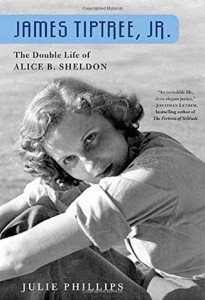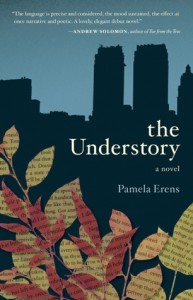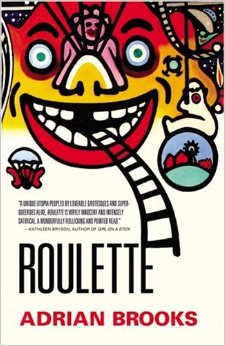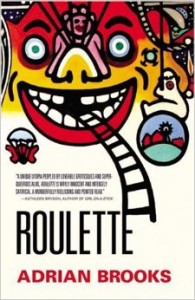Roulette
by Adrian Brooks
Suspect Thoughts Press. 240 pages, $16.95
Roulette is a hilarious, outrageous, and intentionally hokey social and political manifesto, absolutely gay in its rebellious, over-the-top spirit. Like an LSD-induced collision of John Waters, the Marx Brothers, and Joe Orton, the zany plot parallels the sweeping idiocy yet oddly logical ride of John Kennedy Toole’s A Confederacy of Dunces. Structurally, the book is a huge chain reaction that sucks the spirited cast into a cosmic morality battle of epic proportions. Brooks, a San Francisco-based activist and writer who performed with the Angels of Light back in the 70’s, sets the stage for a comic yet cosmically significant conflict that rolls along at breakneck speed. On one side are the real estate developers who want to bulldoze the town of Roulette, a ghost town that’s now inhabited by a ragtag group of artists, gays, whores, and assorted other nomadic renegades who collectively make up the other side. Among the latter is the town’s founder, a drag-inspired character named Gwendelynne Faye Smith who identifies with Scarlett O’Hara. (“Gwen” even has a life of her own in cyberspace: turn up the volume and go to myspace.com/gwendelynnefayesmith.) The cast includes almost every stereotype, including descriptions of delicious-looking young men sprinkled throughout, such as Trimpee from Minnesota and Santiago from Brazil, with his green eyes, olive skin, and dreadlocks. One could easily picture these boys in a movie, and indeed the novel often has the feel of a screenplay, what with its impersonal narrator who presents his characters with the camera’s brutal detachment. As the shit hits the fan, Brooks’ story-telling remains intentionally low key, harmless looking, and modest. “Gwen” and her campy antics are a riot, as are those of the more central characters in Brooks’ tale, which manages to sneak in a lot of biting socio-political commentary via the narrator’s sardonic descriptions of the “good” characters and their reactions to events. Then there are the right-wing real estate sharks and their evil but mostly bungled schemes, feigning moral outrage about their enemies to advance an economic agenda. Sound familiar?
Michael Labelle
 James Tiptree, Jr.: The Double Life of Alice B. Sheldon
James Tiptree, Jr.: The Double Life of Alice B. Sheldon
by Julie Phillips
Picador. 545 pages, $18.
In the late 1960’s, a writer by the name of James Tiptree Jr. began appearing in science fiction magazines. His stories were not only well crafted and tightly paced; they were memorable explorations of identity, gender, and sexuality. The science fiction world soon took notice, and Tiptree began to win Hugo awards, the “Oscar” of science fiction writing, as well as other recognition. But Tiptree proved as mysterious as he was admired. Like Thomas Pynchon, he cultivated a guarded isolation. No one had ever seen or heard Tiptree—his friends and admirers knew him only through the vibrant and engaging correspondence that originated from his Virginia post office box. For years Tiptree dodged award ceremonies, science fiction conventions, and requests for in-person interviews, but the speculation only grew more intense. Eventually, Tiptree’s fans put together enough clues to discover that Tiptree was actually Alice B. Sheldon, a former painter, CIA agent, and psychologist. Julie Phillips’ 2006 biography, now available in paperback, tells this strange story masterfully. With the skill of a novelist, Phillips depicts the life of a fascinating woman whose struggles with her own identity and quest for personal fulfillment will be intriguing even to those uninterested in science fiction. The daughter of wealthy and accomplished parents, Sheldon was blessed with an uncommon childhood. Before she was a teenager she was exploring Africa and other exotic locales with her parents. As a young woman, her pedigree made her one of Chicago’s social elite. She lived a somewhat charmed and certainly a fascinating life, and as a lifelong diarist and an indefatigable correspondent, Tiptree/Sheldon provides her biographer with amazing material. Phillips has clearly used the best of it; her biography is a first-rate chronicle of a unique 20th-century American.
Jim Nawrocki
 The Understory
The Understory
by Pamela Erens
Ironweed Press. 143 pages, $11.95
This is the first novel by Pamela Erens, a short story writer and former editor at Glamour magazine. While she covers some of the same territory mined by novelist Sarah Schulman in the past—the eviction of people of modest means from their once-affordable Manhattan apartments, for example—Erens downplays the political implications of such private events. Set in the last few decades of the 20th century, this is the story of Jack Gorse, a middle-aged man who squats in the apartment of his late, gay uncle and subsists on a small inheritance. Though trained as a lawyer, he is unable to cope with the exigencies of making a living; nor does he have the wherewithal to find a new permanent home. He loves to frequent Central Park’s cruisy Rambles area, but apparently only as an observer, and indeed there is no mention at all of AIDS in the novel. Truly a person who depends on the proverbial kindness of strangers—or at least the kindness of acquaintances such as waitresses, bookstore owners, and librarians—Gorse whiles away his days reading, walking, and fretting. At times the reader may wish they could gently steer him to the nearest psychopharmacologist. When Gorse finds himself falling head-over-heels for an American Buddhist architect and then stalking him, The Understory comes to a gripping finale. Erens, who’s a straight, married woman, is a very talented writer, and this slender volume is a welcome contribution to contemporary fiction.
Martha E. Stone







